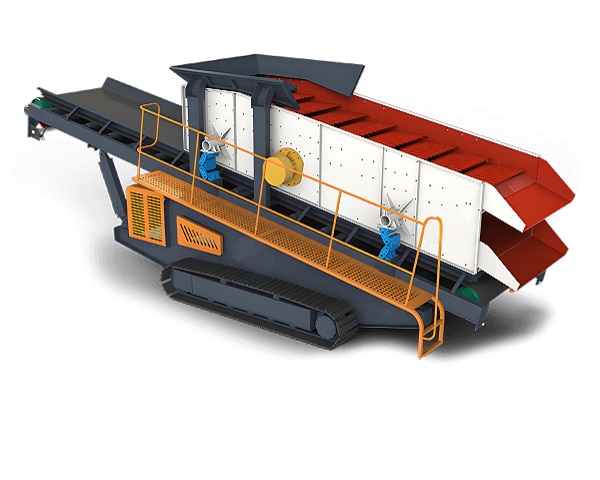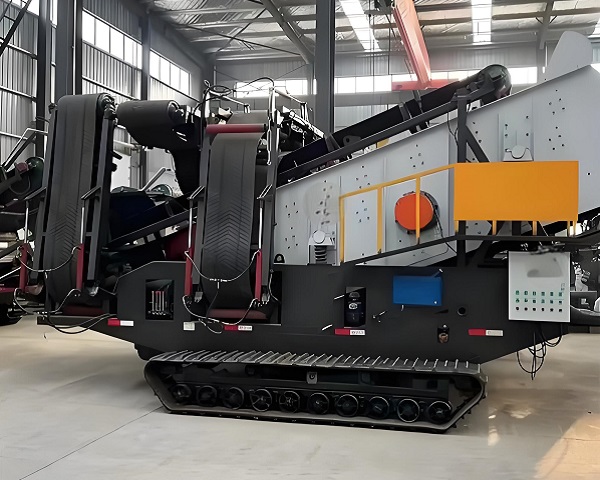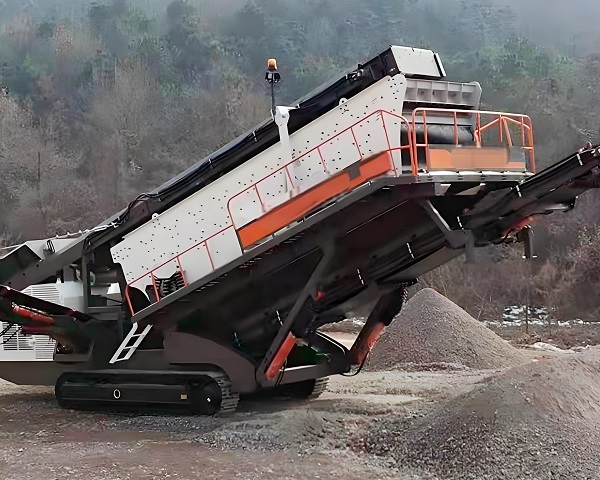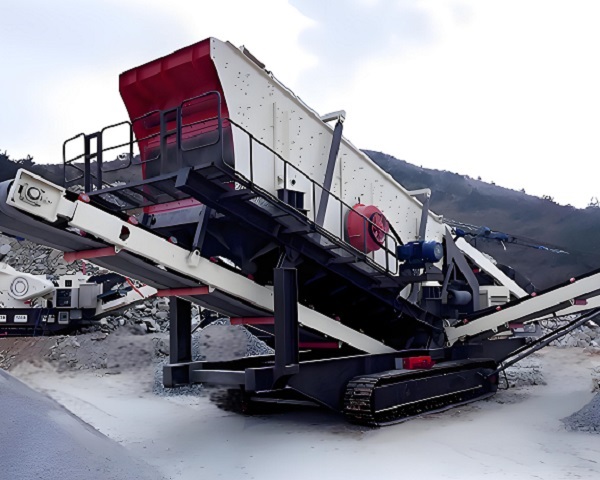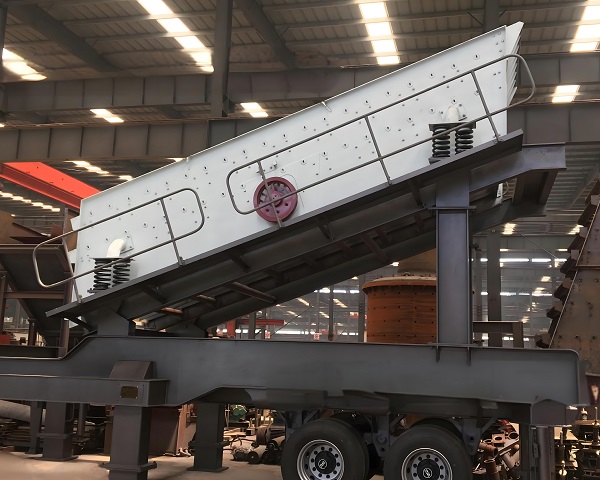A Trommel Screen is a rotary drum screening machine widely used in waste processing, mining, and construction industries. It efficiently separates materials by ......
What is the Mobile Screening Machine for Sale
Mobile screening machine is a modern mechanical equipment that integrates screening, conveying and mobile functions. It is designed to meet the needs of complex construction scenes and efficient operation. Its core advantage is to combine the processing capacity of traditional fixed screening equipment with mobile flexibility, and realize fast transfer and efficient screening through integrated design, which significantly reduces the cost and site restrictions of material handling.
Equipment structure and function
Mobile screening machine usually consists of chassis system, screening unit, conveying system, power module and control system. The chassis is driven by crawler or tire to adapt to complex working conditions such as rugged terrain of mines and construction waste dumps; the screening unit can be equipped with vibrating screen, drum screen or high-frequency screen, and material classification can be achieved through multi-layer screens with adjustable precision; the conveying system uses belt conveyor or chain plate conveyor to ensure continuous material transportation; the power module can be selected from diesel engine or electric drive, taking into account the field without electricity and environmental protection needs; the intelligent control system supports one-key start and stop, parameter adjustment and fault diagnosis, which improves the convenience of operation.
Application fields and value
1. Mines and quarries: used for grading and screening of ore, sand and gravel aggregates, improving the purity and added value of raw materials, and reducing the subsequent crushing energy consumption;
2. Construction waste treatment: separation of impurities such as concrete blocks, bricks, and wood, production of recycled aggregates, and promotion of circular economy;
3. Municipal engineering: screening roadbed materials and backfill soil to ensure the quality of engineering materials and shorten construction period;
4. Environmental protection and solid waste treatment: treatment of domestic garbage, industrial waste residue, sludge, etc., to achieve reduction and resource utilization.
Technical advantages
1. High mobility: no need to disassemble and assemble, can be directly transferred to save transportation and installation time;
2. Flexible adaptation: modular design supports customized screen specifications and processing capacity to adapt to different material characteristics;
3. Energy saving and consumption reduction: optimize the power system and screening efficiency, reduce fuel or electricity consumption;
4. Environmental protection and friendliness: optional dust removal device and noise reduction technology can be used to reduce dust and noise pollution during operation.
With its versatility and high efficiency, mobile screening machines have become core equipment in the fields of sand and gravel aggregate production, resource recycling and engineering construction, providing key support for the industry's green and intelligent transformation.
Operating principle of Mobile Screening Machine for Sale
The mobile screening machine achieves material classification and separation through mechanical vibration or rotational motion. Its core principle is based on the size, shape and density differences of material particles, and combines the equipment structure and power system to complete efficient screening. The following is an explanation from three aspects: core components, screening process and key technologies:
Core components and functions
1. Screening unit: usually uses a vibrating screen, drum screen or high-frequency screen, which is the core component of material classification.
2. Vibrating screen: The vibrator (eccentric block or motor) generates high-frequency vibration, so that the material jumps forward on the screen surface, fine particles pass through the screen, and coarse particles are discharged along the screen surface.
3. Drum screen: It consists of an inclined cylindrical drum and internal spiral blades. The material rotates with the drum and is graded through the screen holes. It is suitable for processing materials with high mud content or easy to stick.
4. High-frequency screen: Use high-frequency small-amplitude vibration to enhance the screening efficiency of fine-grained materials. It is often used for wet screening or fine classification.
5. Conveying system: including feeding belt conveyor, discharging belt conveyor for oversize and undersize to ensure continuous conveying of materials to the next process.
6. Power module: Diesel engine or electric motor drives the screening unit and conveying system. Some models are equipped with hydraulic system to adjust the inclination of the screen surface.
7. Chassis system: Track or tire chassis provides mobility, adapts to complex terrain, and integrates support structure to ensure equipment stability.
Screening process analysis
1. Feeding stage: Materials are fed into the feeding belt conveyor by loaders or excavators and evenly distributed to the screening unit.
2. Grading screening:
Vibrating screen: Materials are layered on the screen surface under the action of vibration force, fine particles quickly pass through the screen, and coarse particles move to the discharging end along a parabolic trajectory.
Drum screen: Materials rotate with the drum, fine particles fall into the lower conveyor through the sieve holes, and coarse particles are discharged from the end of the drum.
Discharging stage: Oversize (coarse particles) and undersize (fine particles) are transported to the designated area through different belt conveyors to complete the grading.
Key technical parameters and influencing factors
1. Screen surface inclination: affects the residence time and movement speed of the material on the screen surface. The larger the inclination, the higher the processing capacity, but the screening efficiency may be reduced.
2. Vibration frequency and amplitude: the core parameters of the vibrating screen. High frequency and small amplitude are suitable for fine particle screening, and low frequency and large amplitude are suitable for coarse particles or materials that are easy to block.
3. Screen specifications: The size and shape of the screen hole (square, round) determine the classification accuracy and need to be selected according to the material characteristics.
4. Material characteristics: Water content, cohesiveness, particle size distribution, etc. directly affect the screening efficiency. For example, wet and sticky materials are easy to block the screen holes, and high-frequency screening or pretreatment is required.
Advantages and features of Mobile Screening Machine for Sale
Mobile screening machine is an efficient screening equipment that integrates feeding, screening and conveying, with the following significant features:
1. High mobility: The tire or crawler chassis design can realize fast transfer operation, which is particularly suitable for projects that need to frequently change the work site.
2. Integrated design: It integrates components such as vibrating screen, feeder, conveyor belt, etc., reducing the time of on-site installation and commissioning, and realizing "ready to use".
3. Modular structure: Each functional module can be quickly disassembled and assembled, which is convenient for transportation and maintenance.
4. Intelligent control system: Equipped with advanced PLC control system, it can monitor the operation status of the equipment in real time and adjust the screening parameters.
5. Versatility: By replacing the screen, it can process materials of different particle sizes, which is suitable for a variety of material screening needs.
6. Compact layout: It can achieve efficient screening in a limited space, which is particularly suitable for working environments with limited space.
Mobile screening machines have many advantages over traditional fixed screening equipment:
1. Reduce transportation costs: Materials can be screened on site, reducing material transportation costs, especially suitable for construction waste treatment, mining and other scenarios.
2. Improve work efficiency: No infrastructure is required, and it can be put into production 15-30 minutes after arriving at the site, greatly shortening the project preparation time.
3. Adapt to complex terrain: The crawler design enables it to adapt to complex terrain conditions such as mountains and wetlands, expanding the scope of operation.
4. Environmental protection and energy saving: Modern mobile screening machines adopt low-noise design and are equipped with dust removal systems to meet environmental protection requirements; some models use hybrid power to reduce energy consumption.
5. Reduce manpower requirements: High degree of automation, reduced manual intervention, usually 1-2 people can operate the entire equipment.
6. Quick return on investment: Versatility and high efficiency enable it to quickly complete project tasks and shorten the investment recovery cycle.
7. Safe and reliable: Equipped with multiple safety protection devices, such as overload protection, emergency shutdown, etc., to ensure safe operation.
8. Precision screening: With advanced vibrating screen technology, the screening efficiency can reach more than 95%, meeting high-standard engineering requirements.
These characteristics and advantages of mobile screening machines make them widely used in the fields of construction waste recycling, mining, aggregate production, soil remediation, etc., and become an important equipment for modern material processing. With the continuous development of technology, its intelligence, environmental protection and high efficiency will be further improved.
Technical Parameter Table of Mobile Screening Machine for Sale
| Specification / Model | MS-200 | MS-300 | MS-400 | MS-500 | MS-600 |
|---|---|---|---|---|---|
| Number of Screening Layers | 2 | 3 | 3 | 3 | 3 |
| Capacity (tons/hour) | 150 | 300 | 450 | 500 | 600 |
| Max Feed Size (mm) | 250 | 300 | 350 | 400 | 450 |
| Power Configuration | 75 kW Diesel | 110 kW Electric | 132 kW Diesel | 160 kW Electric | 180 kW Diesel |
| Mobility Type | Tracked | Tracked | Wheeled | Tracked | Tracked |
| Screen Size (mm) | 3000×1200 | 4000×1500 | 5000×1800 | 5500×1800 | 6000×2000 |
| Weight (tons) | 18 | 25 | 32 | 36 | 42 |
| Control System | Hydraulic | Hydraulic + PLC | Hydraulic + PLC | Smart Electric | Smart Electric |
| Discharge Method | Dual Belt Conveyor | Triple Belt Conveyor | Triple Belt Conveyor | Triple Belt Conveyor | Quad Belt Conveyor |
| Application Field | Construction Waste | Sand and Gravel | Ore, Coal | Mining Screening | Aggregate Production |
If you have any special requirements, we will customize according to your special needs.
Product Picture Display of Mobile Screening Machine for Sale
FAQ about Mobile Screening Machine for Sale
>1. How do mobile screening machines handle wet or sticky materials?
For wet or sticky materials, mobile screening machines are usually equipped with anti-blocking screens (such as polyurethane screen plates, rubber screens) or high-frequency vibration systems to prevent material adhesion and blockage. Some high-end models also integrate water spray devices or heating functions to help separate sticky materials. In addition, the use of inclined screen box design can enhance material fluidity and improve screening efficiency. For extreme working conditions, you can choose a specially designed wet screening model, combined with a water flushing system to achieve efficient separation.
>2. What are the main types of mobile screening machines?
Mobile screening machines are mainly divided into two types: tire-type and crawler-type. Tire-type is suitable for flat sites and is easy to transport; crawler-type is suitable for complex terrain (such as muddy and sloping land) and has stronger stability. In addition, according to the screening method, it can be divided into single-layer screens, double-layer screens and multi-layer screens to meet different precision requirements.
>3. What are the advantages of mobile screening machines over fixed screening equipment?
Mobile screening machines do not require fixed installation and can be put into production quickly, reducing transportation and installation costs; they are highly adaptable and can operate flexibly in different sites; they have a high degree of automation and reduce labor requirements; they also have energy-saving and environmentally friendly characteristics, such as low noise and low dust emissions, which meet modern environmental protection standards.
>4. What industries are mobile screening machines suitable for?
They are widely used in sand and gravel aggregate production, mining, construction waste recycling, soil remediation, coal screening and other fields. At the building demolition site, concrete fragments and steel bars can be quickly screened; in the quarry, stones of different specifications can be efficiently graded.
>5. What is the screening efficiency of the mobile screening machine?
Modern mobile screening machines use high-frequency vibrating screen technology, and the screening efficiency can reach 90%-95%, and some high-performance models are even higher. The screening accuracy can be adjusted by replacing screens with different apertures to meet the different needs of coarse screening (such as above 100mm) or fine screening (such as below 5mm).
>6. What is the power source of the mobile screening machine?
It is usually driven by a diesel engine or an electric motor, and some new models support hybrid power (diesel + electric). Crawler models are mostly hydraulically driven and have stronger power; tire models may use mechanical transmission and are more energy-efficient. Electric models are suitable for sites with stable power supply, while diesel models are suitable for remote areas.
>7. What should be paid attention to in the maintenance and care of mobile screening machines?
Regularly check the wear of the screen and replace the damaged screen in time; lubricate the bearings and vibration motors to prevent overheating damage; clean up the accumulated materials to avoid blockage; check the oil level and sealing of the hydraulic system (crawler type) or transmission system (tire type). Good maintenance can extend the life of the equipment and reduce the failure rate.
>8. How intelligent is the mobile screening machine?
High-end models are equipped with PLC (programmable logic controller) and touch screen operation interface, which can monitor the screening efficiency, equipment status, fault alarm, etc. in real time. Some models support remote monitoring, realize data collection and intelligent scheduling through GPS or Internet of Things technology, and improve production management efficiency.
>9. What factors need to be considered when purchasing a mobile screening machine?
It is necessary to select the appropriate model according to the material type (hardness, humidity), output demand (tons/hour), and site conditions (topography, power supply). Crawler type is suitable for complex terrain, but the cost is higher; tire type is convenient for transportation, but the adaptability is slightly weaker. In addition, energy consumption, maintenance costs and brand after-sales service must also be considered.
>10. What is the future development trend of mobile screening machines?
In the future, mobile screening machines will develop towards higher intelligence (AI optimization of screening parameters), more environmental protection (electrification, low noise), and more efficiency (modular design, fast screen change). With the popularization of 5G and Internet of Things technologies, remote monitoring and automated operation will become industry standards, further improving production efficiency and safety.
>11. What innovative technologies does the mobile screening machine have in terms of environmental protection?
Modern mobile screening machines use a number of environmentally friendly technologies: closed screening structures with pulse dust removal systems to reduce dust diffusion; low-noise engines and sound insulation materials to reduce operating noise (usually controlled below 75 decibels); some models are equipped with hybrid or pure electric drive to achieve zero emissions; intelligent energy management systems can optimize power distribution and reduce fuel consumption. In addition, some recycling-specific models have built-in metal detection and sorting devices to improve resource recovery rates and meet the requirements of the circular economy.


























